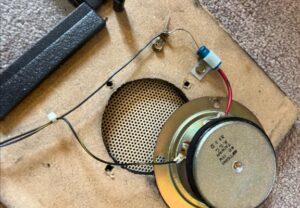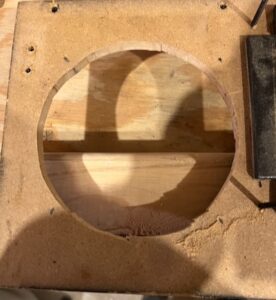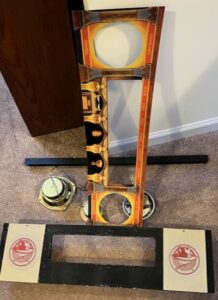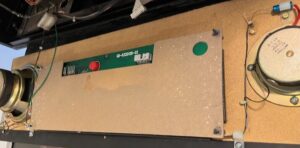
For Williams / Bally WPC pinball machines, there are great speaker kits available. But we like to do things ourselves, plus that right speaker in the backbox is small.
There is a way to fix that.
Note: Click on images for a larger picture.
Also see – how to upgrade your cabinet speaker to a larger, better speaker.
Supplies Needed
Tools
Saw – We use a table jigsaw. But a hand held jigsaw will work. Or a small hand saw.
Drill – Hand held variable drill.
Drill Bits – Typical wood drill bit set.
Screwdrivers – Usually Phillips.
Nut Drivers – English or metric depending on what is being used. WPC uses English screws and nuts.
Soldering Pencil – Typical hand-held 25 to 35 watt.
Solder – Tin/lead solder is used in WPC games.
Supplies For Backbox
5 & 1/4″ Speakers (Pair) – We love Polk speakers for the WPC backbox. Usually about $80 for the pair. Can go on sale for less. DB522 DB+ Series 5-1/4″ Coaxial Speaker. Any 5 & 1/4″ speaker will do, as long as the center tweeter does not extend past the outer ring of the speaker. If it does, a spacer will be needed.
#8-32 Screws – The screws that come with the existing larger speaker might be too long. The ones from the smaller speaker might be short. With the Polk speakers, we used #8-32 x 3/8″ bolt style.
If Upgrading the Sound Board
Speaker Wire – We use #18 or #20. The original WPC wire is only used if not upgrading the soundboard. Prefer solid copper vs copper coated aluminum.
0.156″ Plugs – Get the type to fit the wiring harness in your PinSound Board.
0.156″ Trifurcon Crimp Connectors – Higher quality than the original ones.
Upgrade the backbox speakers. Upgrade the cabinet speaker.
| Note that upgrading the backbox speakers is generally only worth it if you are also upgrading the sound with something like PinSound. The original Williams / Bally WPC sound boards are pretty crummy. The later DCS soundboards are lousy too. Putting better speakers in the backbox will not make it sound much better if at all. But upgrading the cabinet woofer is always worth it. |
Removing The DMD / Speakers Insert
Note: Be certain to turn off the pinball machine. Unplug it from the wall.
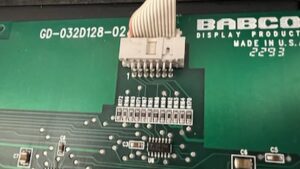
Unlock and remove the translite. Pull up and place the speaker / DMD Insert onto the playfield glass.
Note the ribbon cable has a red stripe. It should be on the side with pin #1. If it is not, check the other end in the DMD board. Both sides should point to pin #1. Installing both ends ‘backwards’ will normally work but get confusing on reassembly.
 Remove the ribbon cable and power connectors and temporarily set them back into the backbox.
Remove the ribbon cable and power connectors and temporarily set them back into the backbox.
Remove the four nuts that hold the DMD in place. Carefully lift the DMD off of the four screws and place the DMD in a safe location where it cannot be exposed to static charges.
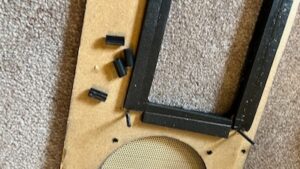
Remove and retain the four spacers on those four screws that were holding the DMD in place. It is important to preserve these and all other parts you are removing.
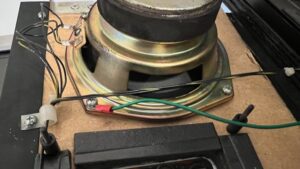 Remove the green ground wire by removing the screw holding it to the speaker.
Remove the green ground wire by removing the screw holding it to the speaker.
Set the ground wire back into the backbox to be retrieved later.
| Note: This step is being done assuming you will install a new PinSound board. If you plan on upgrading these speakers and reuse the existing WPC Williams sound board (see comment above), then instead of unplugging this wire, you can unsolder it from the speaker. |
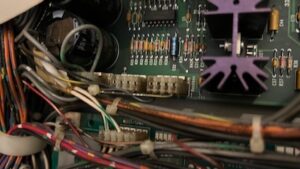
Unplug the connection from the sound board. This connection may vary and you will have to trace the wires.
In some connections, both backbox speaker wires will go to one plug. Just unplug that plug and carefully remove it from the bundle of wires in the backbox to free up this DMD / Speaker Insert.
In other games, one wire will come out of each plug, then be connected together by an in-line plug.
You will need to determine what the wiring is and untangle it so the DMD / Speaker Insert with the speaker wiring can be removed.
Disassemble the DMD / Speaker Insert
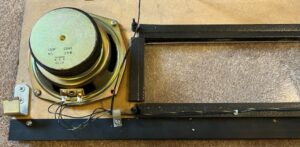
Next, remove and store the screws holding the top plastic trim and those holding the wires in place.
Remove the top and bottom plastic trim.
 Now remove the screws holding the two hangers.
Now remove the screws holding the two hangers.
Remove the screws holding both speakers.
Remove the screws holding the capacitor. This capacitor is the cheap speaker crossover that allows only the high frequency sounds to go through this speaker.
 The front plastic cover is now only held in place by some light glue. Carefully remove this and set it aside. Keep the glue away from other surfaces.
The front plastic cover is now only held in place by some light glue. Carefully remove this and set it aside. Keep the glue away from other surfaces.

With everything removed, your DMD / Speaker Insert should look like this.
The only things left to be removed are the speaker screens and the ‘wire nuts’.
As shown in the photo, carefully insert a small blade screwdriver near the nail and apply a small amount of upward pressure.
The amount of pressure will not be enough to bend the speaker screen. But enough to just lift the nail.
Once the nail has started to lift, stop.
Remove the nail with a pair of vice grips. Just pull it right out without touching the protective, decorative speaker screen.
Save these nails.
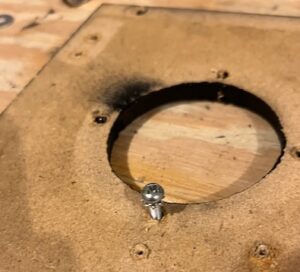
Remove the T-nuts that hold the smaller speaker screws. The easiest way is to insert one of the speaker screws into the wood side of the T-nut and lightly hit the head of the screw. The T-nut will pop right out.
Remove the screw, save the T-nut and repeat. Do this only on the smaller speaker hole.
The T-nut may have some wood still attached to it. If so, carefully scrape off the wood from the T-nut.
Set the T-nuts aside until needed.
Enlarging the Small Speaker Hole
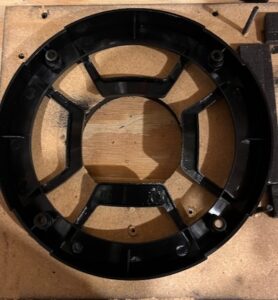
Some of the speakers come with a template for cutting the correct hole. These speakers did not, so we used the speaker cover as a template. We just marked along the inside ring. And used the smaller ring in the middle to insure it was centered in the hole.
Place the template over the hole and check to insure it is centered. Mark the cutting line. Measure and compare this marking to the other hole where the larger speaker is attached.
Cut out the new hole. This wood is pretty soft, so a hand blade can be used. We use a table jigsaw, but a hand jigsaw can be used.
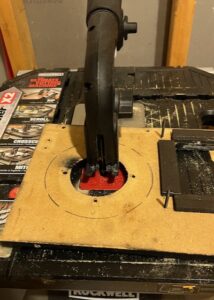 The hole does not have to be ‘pretty’, but it needs to be small enough so that the speaker ring does not expose the hole. And it has to be large enough for the speaker to not hit it.
The hole does not have to be ‘pretty’, but it needs to be small enough so that the speaker ring does not expose the hole. And it has to be large enough for the speaker to not hit it.
With the hole marked, cut the larger hole.
Set the new speaker in position and mark the spots to drill the holes for the t-nuts and screws.
Select a drill size slightly larger than the part of the T-nut that goes through the hole in the wood.
Drill the holes.
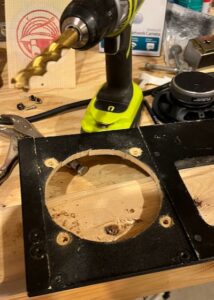 The T-nuts will be mounted on the side with the screen, just like the larger hole has. It is better if these T-nuts are recessed into the hole slightly so as to not push on the screen.
The T-nuts will be mounted on the side with the screen, just like the larger hole has. It is better if these T-nuts are recessed into the hole slightly so as to not push on the screen.
If you have a large enough counter-sink, make the depression necessary for the T-nuts to be recessed.
If no counter-sink, then use a drill bit just a little larger than the flat side of the T-nuts. Important: Set the drill on reverse! Install the drill bit in your drill.
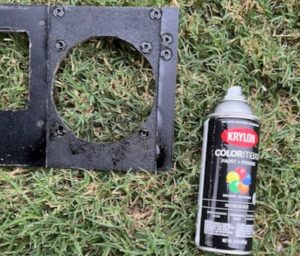 On the screen side, with the drill in reverse, carefully spin the drill bit just enough to carve a recess for the T-nut. Test the T-nut in the hole and run your finger over it to insure that it is recessed.
On the screen side, with the drill in reverse, carefully spin the drill bit just enough to carve a recess for the T-nut. Test the T-nut in the hole and run your finger over it to insure that it is recessed.
The DMD/Speaker Insert should be black on the exterior, or wood will be visible through the speaker screen. Repaint those sections with black rattle can spray paint. You can do this with the T-nuts reinstalled – lightly hammer them into position.
Reassembly
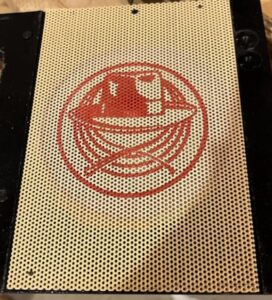 Reattach the speaker screens on the front. Use the same small nails that you removed earlier. It is not necessary to use all four nails.
Reattach the speaker screens on the front. Use the same small nails that you removed earlier. It is not necessary to use all four nails.
Make certain that the screen is oriented correctly and not upside down.
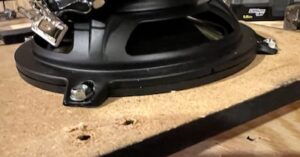
Attach the new speakers into position. Note that the speaker wire connections must face the top of the Insert. This can be identified by the screw holes in the wood that held the top plastic piece and wires in place.

On this brand of speakers, the tabs holding the screws bend down when being tightened. That causes the screws to stick out on the other side and push on the speaker screens. So we used shorter screws. Spacers or washers could also be used to prevent those tabs from bending. We used #8-32 by 3/8″ screws. The original screw is at the top of the pair in the center of the photo.
When attaching the new speaker, be sure to tighten the screws enough to pull the T-nuts completely into their new holes.
Position the original front onto the insert. Slide the top and bottom plastic channels into position.
Reattach the four screws on the top. The two inner ones have those plastic wire guides.
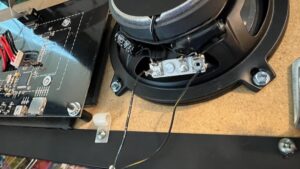
If wiring back up the original wiring, remove that capacitor on the right speaker.
Wire the striped wire to the (+) terminal for both speakers. This insures that the speakers will be in phase.
Plug it back into the sound board.
If putting in a PinSound board, see the PinSound board wiring section.
Insert the spacers onto the four screws that hold the DMD display. Slide the DMD display back into place with the ribbon connector facing the bottom.
 Position the DMD / Speaker Insert on the playfield glass. Reconnect the ground wire to the speaker or the DMD board. If using the DMD board, insure that the screw is grounded.
Position the DMD / Speaker Insert on the playfield glass. Reconnect the ground wire to the speaker or the DMD board. If using the DMD board, insure that the screw is grounded.
Reconnect the ribbon cable and power plug.
Enjoy!
Also see – how to upgrade your cabinet speaker to a larger, better speaker.
Next: Replacing the Cabinet Speaker and Wiring for PinSound.
External Links
Upgrading WPC Speakers – Tony Dziedzic’s excellent guide on how to upgrade your Bally/Williams pin sound.
